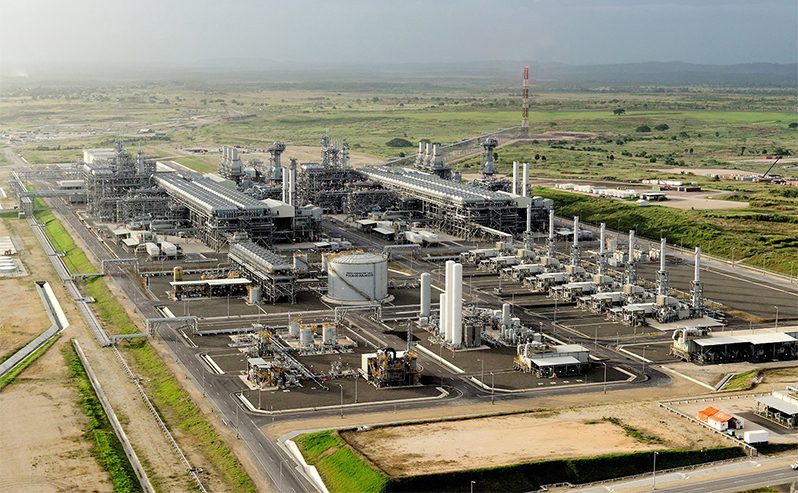In 2004 ExxonMobil championed the cause of monetizing the natural gas in Papua New Guinea, when they proposed a 3000 km long pipeline to Australia. In 2007 feasibility hurdles in the PNG Gas Project resulted in exploring the possibility of an LNG plant in PNG. The joint operating agreement for the PNG LNG Project was signed in 2008 and in 2009 the engineering, procurement and construction contract was awarded to a joint venture of Chiyoda and JGC. The US $19 billion project started production ahead of schedule in April 2014. On May 25, 2014, the Spirit of Hela carried the first shipment of LNG from PNG LNG to the Tokyo Electric Power Co. Inc. (TEPCO) in Japan.1
The plant is located near Port Moresby at Caution Bay in the Central Province of Papua New Guinea. The project, however, extends to Hela, Southern Highlands, Western and Gulf provinces, connected by over 700 kms of pipeline. The pipeline carries conditioned gas from the Hides Gas Conditioning Plant (HGCP) in the Highlands. LNG and Condensate is exported to various customers around the globe including Unipec Asia (a subsidiary of Sinopec), the Tokyo Electric Power Company, Osaka Gas Company and Chinese Petroleum Corporation.2
A mammoth workforce of over 55,000 workers were involved during the construction phase of the project with 21,220 employed at its peak in 2012. As an operating facility, the plant has 2,600 production workers, of which 82% are locals and 22% are women. Over 10,000 Papua New Guineans were trained for construction and operation roles while 200 were trained as operations and maintenance technicians.3 The PNG LNG plant has a lifespan of 30 years and is expected to be in operation till 2043.
An estimated 20% of power demand of Port Moresby is supplied from the plant, in addition to gas to be supplied to the new 58 MW power plant under construction, which will add another 40% capacity.4 PNG LNG prides its efforts towards generating jobs, training local employees & suppliers, transferring skills & knowledge, procuring local goods & services and giving back to the community. The company also sponsors various local events, community organisations and sporting teams in addition to investing in community and infrastructure programs focused on education, health, women’s empowerment, environment and agriculture.
ExxonMobil PNG (EMPNG), the operator of the plant, has highlighted its commitment to preserving the regional biodiversity and has aided the uncovering of several new plant and animal species not previously identified in the country.5
OWNERSHIP (Equity %)
| ExxonMobil | 33.20% |
| Oil Search Limited | 29.00% |
| Independent Public Business Corporation | 16.60% |
| Santos Limited | 13.50% |
| Nippon Oil Exploration | 4.70% |
| Mineral Resources Development Company | 2.80% |
| Petromin PNG Holdings Limited | 0.20% |
General Data
| Estimated Capital Cost (USD) | 19 B |
| Plant Type | Onshore Stick-built |
| Plant Stage | Operating |
| Final Investment Decision (FID) Year | 2009 |
| FEED Contractor | KBR Inc. (Kellogg Brown & Root) |
| EPC Contractor | Chiyoda Corporation JGC Corporation |
| No. of Trains / capacity | 2 Trains / 4.3 MMTPA each (was 3.45 MMTPA each) |
| Production Start Year | 2014 |
| Products | LNG, Condensate |
| Gas Type | Non-associated Gas (NAG) |
Technical Data
| Cooling Media | Air |
| Liquefaction Technology | APCI AP-C3MR™ |
| Refrigeration Train Details: | |
| Propane Strings 1 & 2 | |
| Driver | GE PGT25+G4 DLE Aeroderivative Gas Turbine |
| Propane Compressor | 3MCL804 GE (Nuovo Pignone) Horizontally Split Centrifugal Compressor |
| Mixed Refrigerant (MR) Strings 1, 2 & 3 | |
| Driver | GE PGT25+G4 DLE Aeroderivative Gas Turbine |
| Low Pressure (LP) MR Compressor | MCL805 GE (Nuovo Pignone) Horizontally Split Centrifugal Compressor |
| Medium Pressure (MP) / High Pressure (HP) MR Compressor | 2BCL506 GE (Nuovo Pignone) Radially Split Centrifugal Compressor |
| Power Generation | 7 x Solar Titan 130-20501S Gas Turbines driving ABB Generators |
Refrigeration Train Configuration

Key Facts
- Exxon and its partners had to overcome several challenges with upstream gas production and transport to make PNG LNG feasible. These included:
> Building the ‘Komo Airfield’ to fly in construction materials and equipment for drilling wells that were located in remote, hilly terrain.
> Building the Hides gas conditioning plant (HGCP) to separate out condensates and condition the feed gas to the LNG plant to a hydrocarbon dewpoint of 5°C and a water content of less than 7 lb/MMscf. The HGCP also includes 3 gas turbine driven pipeline compressors to compress the feed gas to 146 barg. 6, 13
> Laying 700 kms of pipelines, a significant portion of which was on difficult terrain including steep slopes up to an altitude of 2100m, swampland, and land covered in thick vegetation. Construction of the onshore pipeline was completed in March 2014, after four years and over 28 million work hours expended. 6 - The LNG Facilities site and surrounding environment were used as an artillery firing range during World War II, and unexploded ordnance was known to be present on the site. The entire LNG Facilities site needed to be cleared by specialist unexploded ordnance clearance teams before construction workers could be allowed on site.11
- An archaeological site clearance program was implemented to salvage artefact material found at or close to the LNG facilities site. The plant site and surrounds have a long history of human occupation and are considered to be important locations for the ‘hiri’ pottery trade that occurred along the gulf coast of Papua New Guinea for over 500 years. 11
- PNG LNG is the first LNG plant with APCI liquefaction technology to use aeroderivative gas turbines as refrigeration compressor drivers. Each train has 2 parallel GE PGT25+G4 turbines driving propane compressors and 3 parallel GE PGT25+G4 turbines driving mixed refrigerant (MR) compressors.
- The plant’s fractionation system is capable of producing refrigerant grade Ethane and Propane which are key components of the liquefaction loops.
- A unique design feature of the gas pipeline supplying the plant is an internal, flow enhancement coating (50-75 microns of dual component epoxy) with uncoated field joints. The design internal roughness of 10 microns , which is significantly smoother compared to the typical roughness of new carbon steel pipes. This helps reducing pressure losses in the 700 km long pipeline. 13
- From 2014 to 2017, ExxonMobil led a systematic debottlenecking effort at PNG LNG that resulted in the plant increasing its nameplate capacity from 6.9 MMTPA to 8.6 MMTPA. Some of the key enhancement made during this time included: 13
> Application of multivariable predictive control schemes to control the plant operation closer to process safety and operating equipment constraints
> Surge control improvements for the Propane compressors
> Increase turbine available power through modification of the High Stage Power Turbine (HSPT) first stage nozzle geometry (installing upgraded stage 1 kits)
> Slugcatcher inlet piping and outlet piping modifications to enhance liquids separation performance between the two sides of the 8-barrel slugcatcher - Since 2010, PNG LNG’s accomplishments in waste management include: 10
> More than 2 million litres of waste oil transferred to PNG businesses for reuse or recycling
> More than 1 million litres of waste oil recycled in Australia
> More than 500,000 tons of scrap metal given to PNG businesses
> More than 135 moxy tyres donated to PNG Ports Corporation Ltd for reuse as wharf fenders in Port Moresby 10 - In 2015, EMPNG, as part of an agreement with the PNG Government, started supplying up to 25 MW of electricity to the PNG grid for local use. EMPNG has also committed to supply natural gas from the LNG plant to a new state-owned gas-fired power generation unit being built near the LNG plant.
- The PNG LNG project has been plagued by security threats, including tribal violence, and opposition from local landowners who feel they have not been fully compensated by the Papua New Guinea government for land use. The PNG LNG project’s operations in Angore, Hela Province, were suspended in June 2018, when workers were evacuated after protesters set fire to construction equipment. As of August 2018, media reports indicate that an agreement between the landowners and the government is in sight. 6,12
- In February 2018, PNG LNG was shut down for several weeks in the wake of a 7.5 Richter scale magnitude earthquake that struck the country’s highlands. The plant was able to restart production ahead of schedule as the damage to its feed gas pipeline was less than initially feared. 7
- In November 2018, the Total-led Papua LNG consortium signed a Memorandum of Understanding (MoU) with the PNG Government for an expansion project. The Papua LNG JV has proposed the development of the Elk-Antelope gas discoveries. The proposed expansion includes the construction of three new 2.7 MTPA LNG trains, producing approximately 8 MTPA, located on the existing PNG LNG Project plant site.8
Source:
1. https://pnglng.com/About/History
2. https://www.hydrocarbons-technology.com/projects/pnglng/
3. https://pnglng.com/About/Project-overview
4. https://pnglng.com/About/Our-Operations/Domestic-power
5. https://pnglng.com/Environment
6. https://knect365.com/energy/article/5891f3ed-db96-47c9-bc86-9c26eee9b91e/everything-you-need-to-know-about-papua-new-guineas-massive-lng-project
7. https://www.reuters.com/article/us-papua-quake-lng/exxonmobil-resumes-quake-hit-png-lng-production-ahead-of-schedule-idUSKBN1HK02L
8. Papua LNG JV signs agreement with PNG Government (http://www.oilandgasaustralia.com.au/papua-lng-jv-signs-agreement-png-government/)
9. https://pnglng.com/Newsroom/Media-Release/PNG-LNG-Plant-achieves-over-13-million-work-hours
10. https://pnglng.com/Environment/Fact-sheets/Waste-Management
11. PNG LNG Environmental Impact Statement, Chapter 4: Producing and Exporting the LNG
12. Deal in sight for PNG landowners protesting Exxon-led gas project
13. Baxi, J. ‘Capacity Enhancement at PNG LNG from 6.9 MTA to 8.6 MTA’, 27th World Gas Conference, 2018






















































